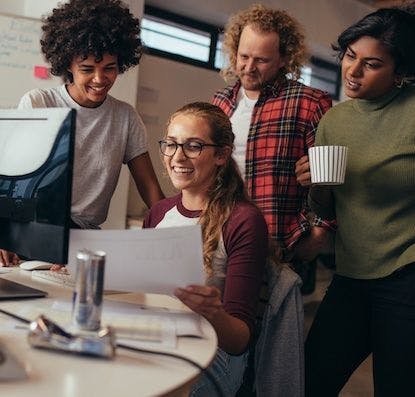TLDR; practice, welcome feedback regularly, and remain biassed towards bringing people together to achieve outcomes.
- Be audience-centric: identify your audience and desired outcomes, then ruthlessly tailor your exercises and experience.
- Prepare: keep any inputs or reference materials handy, for both yourself and others.
- Bring the energy: match your energy to your purpose. Whether it’s injecting a fun or fostering a more serious tone, let it align with your goals.
- Time management: plan your timings, watch the clock and communicate the agenda early.
- Create focus: try engagement activities, change your tone and pace, eye contact through the camera, and use slow, deliberate hand signals to emphasise any key points. Communicate any participation expectations upfront.
- Buddy up: find a friendly face for a practice run and ask for feedback. Bonus points if they can double as your extra eyes & ears/ clarifying voice/ note taker on the day.
But.. how? Embark on a journey into meeting facilitation with me, where I’ll also share why I think these ‘softer’ skills are worthy of a spot on your personal growth journey.
The why
Ever attended a meeting and thought ‘so.. now what?’. Chances are there was either lots of silence, or conversely, it felt dominated by one person. Perhaps also some opportunistic remote multitasking, maybe it was a little directionless at times, or perhaps your only contribution was ‘bye, thanks everyone!’. I’ll say it, a likely culprit was the delivery.
Improving your meeting facilitation isn’t just about skills, it’s a game-changer for better teamwork. When you lead discussions well, you make meetings simpler and more effective. It’s like turning a chore into a chance to really get things done together and align on vision. So, why not sharpen your facilitation game? It’s not just about meetings; it’s about making teamwork easier and more enjoyable.
The process
The task: facilitate a one hour engaging workshop for your team to collaborate on creating shared goals and vision for the coming year.
My journey began with a phone-a-friend chat with a key stakeholder. Never facilitated this type of activity before? No problem, save yourself hours googling and experimenting, by simply asking for some advice. This gave me a rough agenda that would serve as a baseline.
This was followed by a call with the initiative owner, to create buy-in and alignment. We also ideated on strategies for inclusivity, ensuring the meeting time worked for everyone’s time zone, providing a variety of ways to engage and looking at accessibility.
I then infused some fun elements into the agenda — ice breakers, scene setting, and next steps — all designed to elevate engagement and alignment.
Next up, creating the activities themselves. I like to jot down everything that comes to mind, in this scenario it took the shape of a very chaotic Figjam, fueled by the AI generator and snippets from past workshops.
I then ‘changed hats’ to imagine I was the audience, filtering down the exercises to one per agenda point and focused on how they each flowed into the next, imagining how I feel and what I need to know at each step.
Finally a quick splash of design delighters such as stamps and images to make it even more enjoyable.
Shout out to all my fellow Product Managers who may be suspiciously tying this back to the Product lifecycle👋🏽. I confess, this was unintentional, although perhaps let’s save how I PM my build vs buy DIY decisions for another blog..
Insights into Facilitation Alchemy: Tips & Tricks
Delving into the nuances, here are some tips for crafting memorable and effective sessions:
- Psychology of engagement: Dive into the psychology of your audience. Deliberately choose ice breakers to match your purpose. About to ideate? Choose something fun and creative. About to host a retrospective? Perhaps go for something to encourage human connection and vulnerability.
- Friction-free navigation: Remove any hurdles early on. Share a meeting agenda, provide links to useful contextual information and feel free to put distractions ‘on ice’ to come back to later, ensuring full participation in activities. For example, everyone is bustling with ideas, but you’re in the problem discovery phase - create a space for people to jot down ideas as they happen, so they can return focused on the task rather than trying to hold their idea and participate.
- Delighters and dopamine: Add fun exercise names, emojis, colors, stamps and predictable format for a delightful experience. Leverage the joy of choice, how to express yourself - pictures vs sticky notes, favourite colour etc.
- Conscious facilitation: Minimise personal bias by focusing on bringing everyone on the journey. Play back insights, allow silence to encourage expression and try empathise with your audience’s needs.
- Adaptability and breaks: Schedule breaks for longer sessions, incorporating activities like a quick stand up and shake to re-energize and subsequently allow re-focus.
- Encouraging participation: Recognise and approach hesitation with curiosity. You may need to take a step back, allow silence then change your tone and pace, providing reassurance such as “there are no wrong answers” to create a safe space. Open questions can also nudge thinking and encourage involvement. For example, “imagine you’re new to this, what would you need to know?”, “how would this make you feel?”, “can you share any experiences you’ve had that are related to this?”.
- Setting expectations: Clearly define goals and outcomes upfront, fostering a focused and purposeful environment.
- Experiencing the journey: Visualise the journey your participants will experience. Take yourself and a friendly face through the exercises beforehand to identify any potential sticky points and adapt accordingly.
Facilitation is an art that combines intuition, psychology, and adaptability. Whilst there’s no one-size-fits-all approach, pick one or two to try in your next meeting and if you found this blog on LinkedIn, let us know how it goes in the comments!
